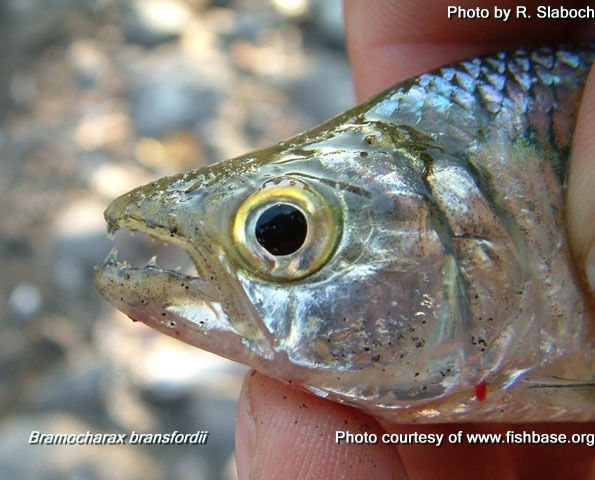 WELCOME TO OPEFE ARCHIVES
WELCOME TO OPEFE ARCHIVESGenus Bramocharax
Characidae
Subfamily: Incertae sedis
FROM FRANK MAGALLANES
This page was originally created in 1995, since then two more new species have been discovered.
The species in general inhabit rivers and streams of little to moderate velocity, occurring between 5 to 530 m elevation. Predator in lakes and rivers. Feeds principally on other fishes such as tetras, Poeciliids and Cichlids, but also consumes terrestrial and aquatic insects to a lesser degree. In life, B. bransfordi is light amber, the gill cover has silvery reflections, and the fins of large adults, particularly the pelvic, anal and caudal fins, are rosy. The pectoral and dorsal fins are clear or pale yellow. In half-grown and juvenile B. dorioni the fins are clear or pale yellow; the caudal fin sometimes has a pinkish wash. Snout shape and size separate the 4 species. B. bransfordi have a slightly higher average anal and pectoral fin ray number than B. dorioni. However, the lateral line scale number is lower when compared to B. dorioni.
The other interesting physiological difference is that B. brandsfordi has two (2) canine teeth that overhang the lower jaw.
For more than half a century Bramocharax was known only from Nicaragua. Additional specimens were collected by Bussing in Costa Rica and recently reported (1967). The Guatemalan form is distinctly different from each of the more southern representatives of the genus. Of the southern populations, Bussing remarked that a faunal assemblage including Bramocharax probably had its origin in the great lakes of Nicaragua and ... seems to be moving southward along the broad lowlands of Atlantic Costa Rica.
B. baileyi is a slender bodied, long-snouted from of Bramocharax. The humeral spot is vertical, extending below lateral line.
Dorsal fin rays 11 (13); anal fin rays, 25 (1), 26 (3), 27 (6), 28 (3); pelvic fin rays (sum of right and left counts), 16 (13); pectoral fin rays (sum of right and left counts), 25 (1), 28 (4), 29 (3), 30 (4), 32 (1); lateral line scales, 36 (1), 37 (9); scale rows on left side (counted obliquely backward and pelvic fin origin), 14 1/2 (7), 15 1/2 (5). The first known sample of B. baileyi was taken in the Rio Dolores. Abundant catches of poeciliid genera (Xiphophorus and Heterandra) were taken with B. baileyi.
In relative snout length B. baileyi is intermediate between B. dorioni and B. bransfordi and in six diagnostic dentitional features B. dorioni and B. bransfordi are similar, but distinct from B. baileyi. Likewise, in the single diagnostic pigmentary feature B. dorioni resembles large B. bransfordi which also has the humeral spot well developed only above the lateral line. In fact, B. dorioni and B. baileyi exactly resemble each other only in having the upper canines concealed, rather than overhanging the lower lip when closed (unlike B. bransfordi).
VALID SPECIES LIST 2011
|
Bramocharax baileyi Rosen 1972
Usumacinta river basin, Guatemala. |
Bramocharax bransfordii Gill 1877
Synonym B. elongatus Lake Nicaragua and Lake Managua basins, Costa Rica and Nicaragua. |
Bramocharax caballeroi Contreras-Balderas & Rivera-Teillery 1985
Catemaco Lake basin, Mexico. |
Bramocharax dorioni Rosen 1970
Usumacinta river basin, Guatemala. |
REFERENCES
Benine, R., V.A. Bertaco, P.A. Buckup, L. Casatti, F. Langeani, F.C.T. Lima, C.A.S. Lucena, Z.M.S. Lucena, L.R. Malabarba, M.C. Malabarba, N.A. Menezes, C. Moreira, O.T. Oyakawa, C.S. Pavanelli, J.F. Pezzi da Silva and R.E. Reis, 2001. Characidae.. pp. In [Editorial list.]. Checklist of the Freshwater Fishes of South and Central America. In preparation.
Géry, J., 1977 Characoids of the world. T.F.H. Publications, Inc., N.J. 672 p.
McAllister, D.E., 1990 A working list of fishes of the world. Copies available from D.E. McAllister, Canadian Museum of Nature, P.O. Box 3443, Ottawa, Ontario K1P 6P4, Canada. 2661 p. plus 1270 p. Index.
Bussing, W.A., 1998 Peces de las aguas continentales de Costa Rica [Freshwater Fishes of Costa Rica]. 2nd Ed. San José Costa Rica: Editorial de la Universidad de Costa Rica. 468 p.
Eschmeyer, W.N., Editor, 1998 Catalog of fishes. Special Publication, California Academy of Sciences, San Francisco. 3 vols. 2905 p.
Rosen, D. E. 1972 (21 Aug.) Origin of the characid fish genus Bramocharax and a description of a second, more primitive, species in Guatemala. Am. Mus. Novit. No. 2500: 1-21.
Gill, T. N. and J. F. Bransford 1877 (10-17 July) Synopsis of the fishes of Lake Nicaragua. Proc. Acad. Nat. Sci. Phila. v. 29: 175-191. ["The ... determination of the species rests chiefly with Dr. Gill." Gill is regarded as the author of the new taxa.]
Contreras-Balderas, S. and R. Rivera-Teillery 1985 (Sept.) Bramocharax (Catemaco) caballeroi subgén. et sp. nv., del Lago de Catemaco, Veracruz, Mexico. Inst. Inv., Cient., U.A.N.L., Mexico v. 2 (no. 1): 7-29.
Rosen, D. E. 1970 (22 Oct.) A new tetragonopterine characid fish from Guatemala. Am. Mus. Novit. No. 2435: 1-17.
USE YOUR BACKSPACE OR CLICK HERE TO RETURN OTHER PREDATORY FISHES
CLICK HERE TO RETURN RESEARCH PAGE
The OPEFE web site and its contents; is disclaimed for purposes of Zoological Nomenclature in accordance with the International Code of Zoological Nomenclature, Fourth Edition, Article 8.3 and 8.4. No new names or nomenclature changes are available from statements at this web site.
Copyright© 1994-2012 Oregon Piranha Exotic Fish Exhibit (The OPEFE fish exhibit is permanently CLOSED as of 2000) Sutherlin, Oregon. Information posted on this web site is archival data on fish scientific classifications and other information. DISCLAIMER: The copyrighted material may not be used for any purpose other than private study, scholarship or research. Cited information requires credit and this link www.opefe.com. All rights reserved. All images shown (unless otherwise noted) is property of OPEFE.
UPDATED: 12/05/2015